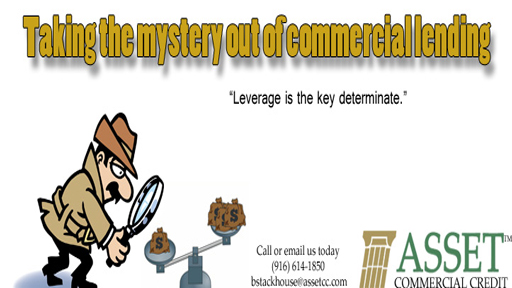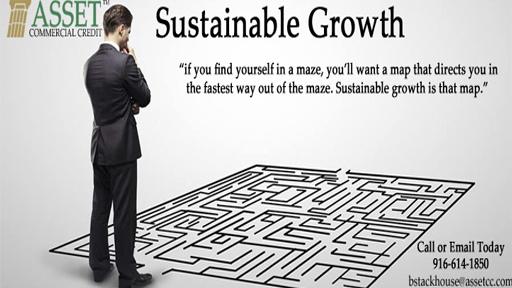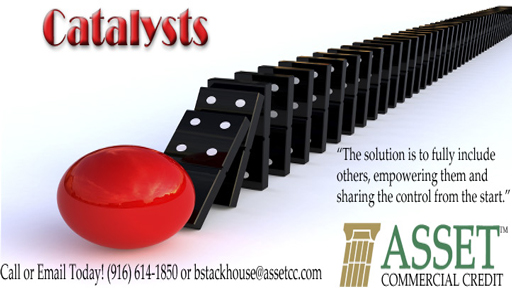Most people believe that one should never accept high interest rates on money borrowed. If you think this is always the answer, then you might want to read on and think again. Yes, it is prudent to get the lowest rate possible when you can get the funds that you need to fulfill your plan. BUT, and that is a very big BUT! Consider the case where one can grow beyond self imposed growth limitations. I’ll start my case discussion with a couple of concepts: controllable growth, lending constraints, value received and contribution margin. Controllable growth will be different for every company, largely because of differing strength of management, resources, and processes. Nothing in this blog means to suggest that any company should grow faster than the rate that they can control. Nevertheless, I have found that many companies do have the ability to grow but are constrained by a lack vision and of capital. Typically, their management is focused on “not paying taxes”, or avoiding interest expense at all costs. Their shortsightedness is their true constraint. As we look at lending constraints, let’s look at standard bank financing first. Banks are valuable lending entities that tend to have comparably low rates. Their acceptable risk profile is usually limited by five components, the company’s leverage and their historical ability to service term debt. Primary source of repayment must be also supported by a good back-up plan, or secondary source of repayment, followed by the payment history of those involved. The bottom line is that many businesses can only obtain enough bank credit to traverse a slow growth curve. In many cases this is the wise path. Though, there are many cases where a given company’s management wants to grow faster than they can with limited availability of credit. It is those instances that I’m focusing on here. It is easy for a business owner to think of financers as just a conduit for money. Many also believe that loans are a commodity. My meaning here is that they think all loans with the same interest rate are the same. Conversely, I have found that initial loan conditions plus banker’s flexibility and patience toward variations in business plan implementation are differentiators. Also financers can add value through their connections, knowledge & experience, and direction. It is important to understand all of the benefits you receive when dealing with a particular financer. Contribution margin is a concept that deserves its own blog. One can Google the subject and be blasted by charts and graphs and heavy “accounting speak”. It is truly appropriate for all business owners to fully understand contribution margin, so read as much as you can. The quick explanation is that contribution margin is the profit value of an incremental dollar’s increase in sales. This is important because it enables management to make valuable decisions about when to continue to grow and when enough is enough. One more thing about contribution margin is that you do not calculate it by looking at your net profit percentage. You just look at costs that vary with sales. Fixed costs or overhead remains constant, therefore additional sales yield more profit than just the historical net profit percentage. Let’s say you have outstretched your growth based on borrowing availability at cheap lending rates, yet more money is available at higher rates. Let’s also say that the higher rates still allow for growth and increased profits. Then why would you choose to miss the opportunity just because you are overly focused on the wrong thing? Indeed, many businesses make the shortsighted mistake of bridling their growth just to avoid taxes or get the lowest interest rate. Cheaper isn’t always better. Conditions, flexibility, customer service, and the ability to achieve your goals are all worthy of consideration. Feel free to give me a call and I’d be happy to talk with you about what is constraining your growth and ways to overcome roadblocks to success. Bob Stackhouse, President, Asset Commercial Credit © Bob Stackhouse
How do I grow my business?
The question that is on the mind of owners of small business everywhere: How do I grow my business (and make more money)? There are a lot of elements that are critical to growing small business: bringing good value to the marketplace, quality people, the right amount of business structure for the position in the life-cycle curve, etc. The list goes on. It seems that one impediment that is consistently dogging businesses across industries is access to cash. It takes cash to purchase inventory and pay payroll while one waits to collect receivables. This article will touch upon the most common financing methods that businesses use to accomplish their growth goals. Feel free to contact us to discuss your situation and the choices that may make sense for your business. Capitalization Many businesses are formed with injections of cash. Frankly, financiers want to see that the owner has skin in the game. Often the initial capitalization is from personal reserves, friends & family, the sale of other businesses, or through home equity loans on the principal’s residences. Capitalization from outside investors is discussed later under Angel Investors / Venture Capital. Banks in particular, like to see that a company is capitalized at least to the level that is common in the businesses’ industry. Trade Credit Suppliers typically offer terms for their regular customers. Some specialty industries offer extended terms (called dating or invoice dating). Some suppliers offer discounts for quick payment. It is common to see 2/10 net 30 as offered terms. That means the supplier will accept a 2% discount if paid in 10 days, but the invoice is due in 30 days nevertheless. Banks want to see that the balance on trade credit does not exceed the balance in inventory. Otherwise they think that the business has diverted sales proceeds from paying the payables that supported the inventory from the sale. They also look at the ratio “payable days” as compared to industry averages to see if the business is overly relying on trade credit. If one does not have a bank and suppliers are patient, some businesses grow via stretching the trade credit. Lines of Credit Traditional bank lines of credit are at the forefront of most business owners’ thoughts. Business owners tend to get frustrated when they are declined for a line. Banks tend to charge Prime + X, with X being 0-5%. Lines are typically granted when there are both primary and secondary sources of repayment; collateral is available (whether or not taken); and debt to worth ratios fall within industry guidelines. Secondary sources of repayment means that there is a reasonable back up plan if something goes wrong the original plan. This can include collateral, financially supported guaranties, or multiple distinctly separate sources of repayment. Non-bank asset based lines of credit fall into this category. Factoring Many businesses want to grow faster than their sustainable growth rate. Often the businesses’ debt is out of proportion to their net worth. Factoring solves these problems. Factoring is the process of selling the businesses’ accounts receivable. Typically a receivable can be sold once goods or services become verifiable with the buyer of the goods or services. This can provide cash to meet payroll and cover inventory purchased on short terms. Factoring is a good choice for high growth companies. It tends to be a poor choice for companies with very small gross profit margins Letters of Credit Sight Letters of Credit are very common with international transactions and are sometimes used domestically with large transactions. A bank, supporting the buyer of the goods provides a letter of credit that stipulates the terms of the purchase. The bank’s credit supports the transaction, not the buyer. Upon presentation (sight) of certain documents as specified in the letter of credit, the bank pays. Occasionally a letter of credit is drawn for sight plus a number of days, perhaps 90 days. That means that the bank pays 90 days after valid paperwork is presented. In such cases the buyer gets terms. The seller may have the option of selling the approved but not paid letter of credit in the Banker’s Acceptance market thereby getting cash earlier than the 90 days. Leasing Some companies are equipment heavy. Term loans and leasing tend to be very good choices. Basically, banks and leasing companies see equipment as good collateral (secondary sources of repayment) therefore they tend to have very good rates for leasing. Since the leasing company owns the equipment and you are renting it, they have an edge on other lenders in a businesses’ bankruptcy. This allows leasing companies to be a bit more liberal that equipment lending institutions. Vendor Financing Vendor financing is a choice that many businesses fail to properly consider. Vendors often make arraignments with a lender to finance their sales on a more liberal basis than they would otherwise do. Lenders may ask the vendor to guaranty a re-purchase of the items sold if the bank were to have to repossess an item. The vendor may also subsidize the interest rate. Often the bank will witness a very low loss ratio with respect to a particular type of equipment, thereby allowing them to justify more liberal lending criteria. Sale Leaseback of assets Some established companies with equity in the equipment have an opportunity to grow. It may make sense for them to sale their equipment to a leasing company and lease the equipment back. This strategy allows the company to receive cash for other purposes (payroll, inventory or even other equipment purchases). Government assisted programs/grants A variety of programs exist by industry and location. Some programs are sponsored at the National level, some at the State level and some at a local level. Programs include farm subsidies, SBA guaranties, micro loan programs and rarely locally distributed community development block grants. The more common national grants support specific types of innovation. Private industry has been known to issue grants, though these are hard to find. Google search will be your friend
Taking the mystery out of commercial lending
Have you ever wondered why one company gets an unsecured line of credit, another company’s credit facility is secured by all assets, and still others are declined entirely for commercial credit? The equation is both complicated and simple at the same time. “What were the odds?” as my esteemed colleague, author and friend Larry Mandelberg would say. Let’s start with simplicity. The simple version answers the mystery of commercial financing. The complex version speaks to the nuances between how various lenders, regulators, and risk managers see a credit request. I’ll deal with the complex version in another blog entry. Basically, it is a risk – reward equation measured by leverage. It is not the lender’s prediction of whether or not you are going to fail. Consider the following: [1] In order to actually collect on accounts receivable in a default situation, the lender must know who is owed, have their contact information and preferably be in a position for the accounts to be sending their payments directly to the lender. Without heavy monitoring, it is not practical for a lender to gather this information at the last minute when a borrower is in default. It all comes down to leverage and who has the most to lose. Leverage is easily discerned by the company’s debt to worth ratio. Different industries have different typical debt to worth ratios and are weighed unique to each industry’s norms. From a general perspective a 1:1 debt to worth ratio means that the business owner’s equity equals the company’s debt. It also means that there are enough assets (at cost) to cover the debt. The equity provides a cushion for something that might go wrong in the future. Banks tend to have minimal conditions when lending to companies that have debt to worth ratios at or under 1:1. Some companies are more leveraged. Perhaps their debt to worth ratio is closer to 1.5:1. These companies will typically be financed with secured lines of credit or secured term loans. As one approaches a 2:1 debt to worth, credit facilities become heavily conditioned and collateral is monitored to some extent. Some special industries may obtain financing at higher leverage ratios, but the ratios must be under the norm for that industry. So there you have it. Leverage is the key determinate. Though do not get me wrong … there is a more complex version that all financers use to evaluate total risk and suitability for inclusion in their loan portfolio. Included are: debt service, competition, industry, payment history, outlook, assessment of management, age of business, etc. Bob Stackhouse, President, Asset Commercial Credit © Bob Stackhouse Feel free to give us a call to discuss which category of finance is appropriate for your business.
Sustainable Growth
You may have heard the words sustainable growth and not thought much more about it. You may have even studied about it in college. Unfortunately many business people forget what they learned because they are too busy or distracted with all of the details of their business. After all, sustainable growth is a concept within accounting and accounting is for someone else … isn’t it? … No! No! No! First, accounting is for every successful business person. Accounting is like a pilot’s instruments when he/she is flying at night in the fog. Accounting is like the marauder’s map in Harry Potter. Harry needs to know when Snape is just around the corner. Accounting is more than your friend, it’s your eyes and ears when you can not be everywhere at the same time. Next, Sustainable growth is more than a concept or theory. It is a practical method of calculating how fast you can grow naturally without the infusion of cash from an outside source. If you are in business, studying sustainable growth is the key to maximizing your opportunities. Think of it this way … if you find yourself in a maze, you’ll want a map that directs you in the fastest way out of the maze. Sustainable growth is that map. The way to understand sustainable growth is like building a house. Start with the foundation and then build your home. The foundation is pretty simple. You can only grow as fast as you retain profits. The formal way investment bankers define this to their public companies is: Return on Equity minus dividends. Unfortunately it does get more complicated than that when you look at small businesses. Let’s use an example: Let’s first look at one business cycle. Say you have 1,000 in cash to start a business. You buy inventory for $700. You pay someone $200 in commission for each sale. And you pay someone $100 per week to handle paperwork and shipping. You sell the goods for $1,200. That returns you your initial $1,000 plus $200 profit after you collect from the buyer. We’ll ignore taxes and many more overhead components to keep the example simple. This is one business cycle. It may take days, weeks, months or years, depending on the product/service & business. You think to yourself … gee … let’s double things right away because twice as much is a good thing. You tell your sales person, good job. Now, go ahead and sell two. The person jumps right on it and sells two. Now, you have a problem. You only have $1,200. You need $1,400 to buy two products at your cost. Your business either blows up by upsetting your customer, or you ship one and tell the customer they have to wait, or you talk the supplier into trade credit, or you use your credit cards. Oops, then there is payroll. You owe the sales person $400. in commission and the paperwork & shipping person $100. In my scenario, the paperwork person can handle the additional work because it is the same week. You don’t have the money to meet your obligations and are faced with missing a payroll or borrowing money from someone, or like many businesses do, don’t pay your taxes. None of these situations are good for long term success. Too much growth, too fast! Not sustainable. Ouch! Unlike the out of control growth in the above “doubling immediately” scenario, Sustainable Growth is the amount of growth you can accept within your financing constraints. You’ve probably figured that after five business cycles, you’ll have your original $1,000 plus $1,000 in profits. At that time you can afford to sell two units. After another three cycles you can afford to sell three units. At some point you’ll reach the capacity of the paperwork person and you’ll need two of them. At some other point, you’ll hit the capacity of the sales person to sell and you’ll need additional sales people. And this is how a business grows naturally, sustainably. OK, so let’s complicate the equation. Real businesses tend to overlap their business cycles, not complete them end to end. They tend to be always selling, always buying, always servicing, and always collecting. Hopefully they have enough capital to support a given level of sales. Now they want to know if they can grow beyond a particular ceiling or how they can grow at all. So, how fast can they grow? The foundation continues to be: retained collected profits fuel or make additional cash available to pay for increased cost of goods sold which enables sales to increase. But we cannot stop here in explaining sustainable growth. We need to answer the question, what fuels the creation of cash? The sustainable answer continues to be retained collected profits. Is there anything other than profits? Yes, it is important to note that there are significant temporary methods of gaining incremental growth. Once these methods are implemented, they hit a ceiling or maximum point of effectiveness for incremental growth. These methods are collecting receivables faster, selling your receivables, stretching out accounts payables, sale of unused assets, shorten the business cycle, make efficiencies in the delivery of products or services (do more with less), and defaulting on debt (employee taxes). OK, so I’ve missed some options that are unique to certain industries, but you get the point. Some managers have success with these methods but seemingly don’t understand why they hit a growth ceiling. My answer is that you can only collect receivables so fast after which you upset your customers. You can only stretch payables so far and then they put you on COD. You can only push your employees so far until they start to become less efficient. The government will only put up with delinquent taxes for a short while, and then they really get in your way of operating the business. Business efficiency and automation can be continually effective for certain types of businesses, but not all types of businesses.
Catalysts
New managers will often jump right in, see a problem and fix it. Quick action and stopping a problem from festering is their focus. Indeed, this does make sense some of the time. Conversely, seasoned managers will often look at a problem and dissect it to the root causes of the problem. Then a solution can be designed that when implemented, the problem solves itself. I like to think of this as being a catalyst. I’ll start with an example of a volunteer organization. It could be a charitable cause, a religious institution, community event or even a school’s parent organization. I’d be surprised if you have not seen instances where a volunteer will solve problem after problem, only to find that they are doing all the work. They tend to get frustrated, burning themselves out. Once they quit, others step in. They are perplexed as to why they never received help when they wanted it. Let’s examine this scenario. Why does the volunteer jump in with both feet, putting them self at the heart of every need or crises? Typically, their activity starts innocently. They have a talent or skill that is needed to solve a problem. They jump in and solve it themselves because it is quicker to do so. Task completion strokes their ego in addition to their feeling needed. They get a feeling of control and power. It feels good. Let’s face it, everyone needs some degree of control in their lives. Sometimes the “control” gets out of hand. Why can’t they get help when they need it? Often, others could have participated in the solution, but space was not made to accommodate them. Sometimes other volunteers even show up to help. If no action, guidance, coordination or structure is available, they often feel unneeded or un-empowered to help. The other volunteers shift their efforts to other projects thereby leaving the original volunteer alone, doing all the work … alone. The solution is to fully include others, empowering them and sharing the control from the start. So what is another example of being a catalyst? Let’s say that a given company is under-performing, employees argue, there is no sense of teamwork, and high turnover is the pattern. If you have another example in mind, feel free to picture it instead. So, we are looking at a company with a problem. The first thing to look at is not trying to understand what people are fighting about, or who is at the center of controversy. Clearly, you will end up there, but that is not the first place to look. Basically people tend to fight when certain organizational development steps are absent. The first three things to look at are Mission, Values and Vision followed by structure. I’ll be writing about these items in subsequent blogs, so keep an eye out. In short, employees and customers need to clearly understand what the company does and how they fit into the mix. They need to understand the core rules that decisions must be consistent with. They need to understand the path to success for both themselves and the company. Many companies have done work in this area without truly understanding the significance. Their employees and efficiency suffer needlessly. Remember to try to understand the root cause of problems and ask yourself: Is there something that I can do so the problem or situation solves itself? Bob Stackhouse President Asset Commercial Credit © Bob Stackhouse – All rights reserved Whether you are in management or just trying to solve problems in your local church, it pays to understand human behavior and advanced methods to solve problems. It also pays to have a coach as you develop your managerial skills. Think about it. Even the most talented sports athletes, journalists and talented actors have coaches, mentors, and directors. Why not managers too? The answer is that the best managers use coaches, mentors and confidants as well. Coaches can help you discern which problems need to be worked with which methodologies. Give me a call if you are looking for one. I am connected to a large number of coaches that belong to The Institute of Management Consultants. This is an organization that drives ethics in the industry.





